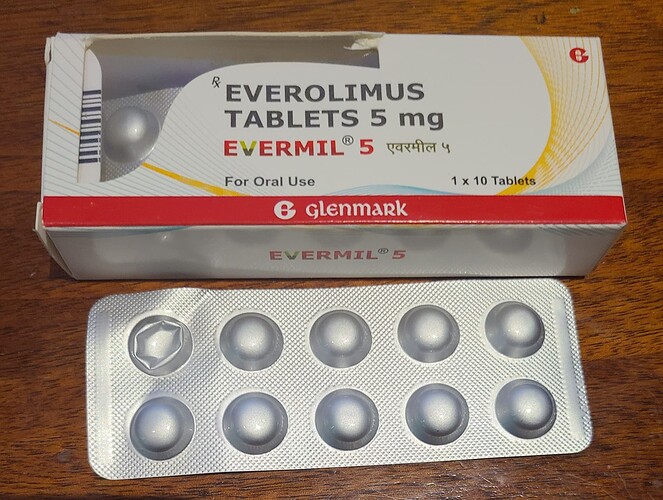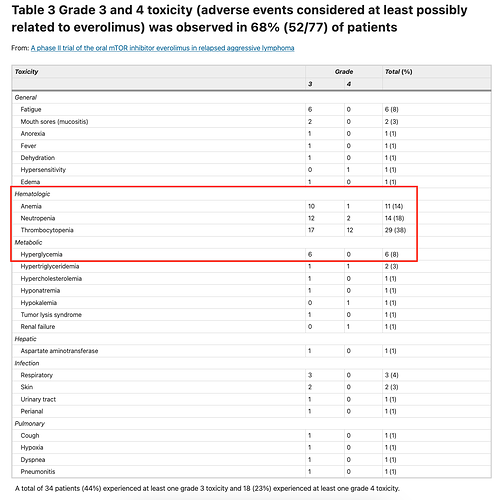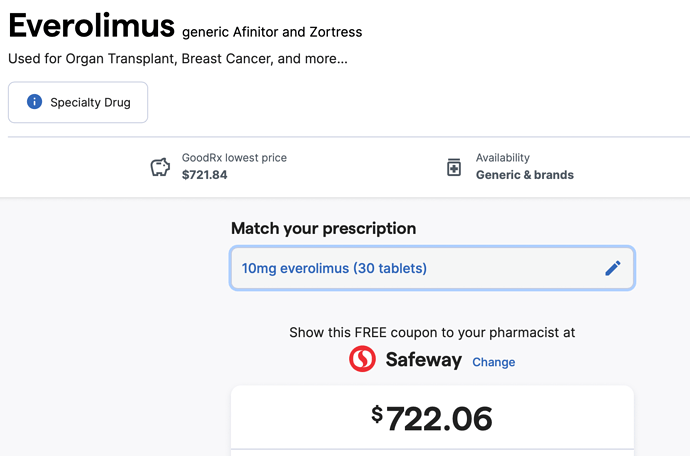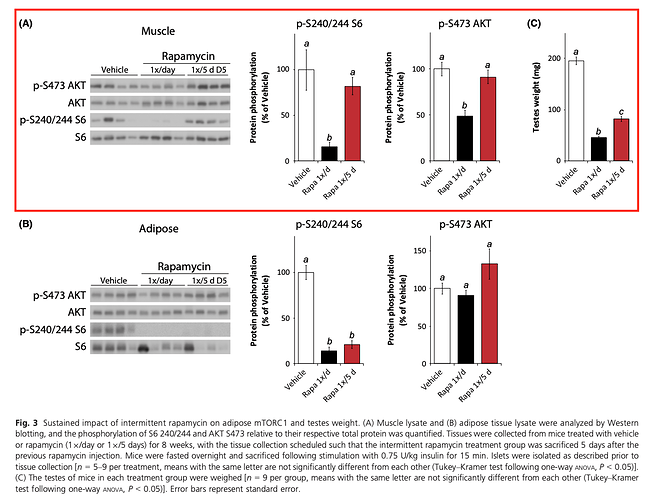its called Evermil 5mg, made by Glenmark of an Indian pharmacy
thank you very much!
@RapAdmin I recall you are trialing Everolimus? Have you noticed any difference to Rapamycin?
As @shc states above it certainly makes sense intuitively.
Not yet. I plan to order it in the coming month.
i bought 20 pills from NIBA healthcare of India. One pill costs $7.
try 5mg Everolimus yesterday with grapefruit juice, no side effect, feels good like the first time i took sirolimus months ago. I will try more times.
according to research papers, Klawitter 2015,
“One of the key differences between sirolimus and everolimus in these studies was that at therapeutically relevant concentrations everolimus, but not sirolimus, could distribute into brain mitochondria”. On the other hand, it said “everolimus is markedly more potent than sirolimus in inhibiting mTORC2 formation”.
Looks like it has both positive and negative effects. May be you just need only few mg of everolimus to reach the brain, you dont need 20 mg of sirolimus to cross BBB.
Yes, interesting conclusions in that paper. I think most of the community still believe MTor2 inhibition leads to greater side effects?
From the Klawitter paper:
“There is also evidence that everolimus alone, but not sirolimus, stimulates mitochondrial oxidation. In rat brain slices, in contrast to sirolimus which reduced high-energy metabolism, everolimus stimulated high-energy metabolism as indicated by significantly higher phosphocreatine and NAD/NADH concentrations.”
I’m not sure stimulating high-energy metabolism is a good thing for anti-aging effects.
We need lifespan studies with everolimus.
Posted elsewhere, albeit transgenic EGFR mice. 85% lifespan increase…MASSIVE!
Interesting… yes we need lifespan studies with Everolimus.
Mitochondrial oxidation sounds negative…
but…
higher phosphocreatine and NAD/NADH concentrations seems like it could be positive:
but I need to dig down much deeper into NAD/NADH ratios and the whole issue of correlation vs. causation to better understand this issue:
Yes, not clear which is positive, and which is negative.
My view is that biochemical pathways are generally too complicated to base predictions on (this is esp. true for massively complicated pathways like NAD-related pathways).
So theory-less empirical evidence is always what I prefer. We have that (albeit mostly in mice) with rapamycin, so I’m inclined to stick with rapamycin.
Actually some of the side effects from 20 mg dosing are a bit concerning like thrombocytopenia and neutropenia.
Clinical remission of an inoperable malignant insulinoma by the combination treatment with octreotide and everolimus (2018)
This is an n=1 patient with existing cancer, treated with Everolimus 10mg/day, albeit dual drug intervention.
Abstract
"We report a 52-year-old woman with inoperable malignant insulinoma with multiple liver metastases. Histological examination of biopsy specimens from the pancreatic and hepatic lesions revealed pancreatic neuroendocrine tumor (pNET), G2. The tumor cells were positive for somatostatin receptor (SSTR) 2, 5, and the mammalian target of rapamycin (mTOR). Monthly intramuscular administration of octreotide LAR and once-daily oral administration of everolimus combination treatment markedly reduced the sizes of liver metastases, and hypoglycemia was
well controlled. Combination treatment with somatostatin analog and mTOR inhibitor may be another effective approach in inoperable metastatic malignant insulinoma.
After 20 months of combination treatment with octreotide and everolimus, all of the metastatic lesions of the liver were reduced in size, and many of those had disappeared. In addition, swollen lymph nodes around the pancreatic tumor had also disappeared."
20+ months at 10mg/day Everolimus, that is a high and long dosing exposure, likely high plasma and AUC levels. No data was reported of any side effects concerns.
From the paper: Clinical remission of an inoperable malignant insulinoma by the combination treatment with octreotide and everolimus (2018)
Recently, everolimus, an orally active mammalian target of rapamycin (mTOR) inhibitor, has been shown to have antitumor growth effects in patients with pNET.3 The protein of mTOR is a serine/threonine kinase that regulates cell growth, proliferation, and metabolism. In pNETs, the expression of mTOR protein is upregulated.9 The expression and activity of mTOR and its downstream targets such as 4EBP1, S6, and eIF4E are strongly dependent on enhanced proliferative capacity and metastatic sta- tus in gastroenteropancreatic neuroendocrine foregut and mid- gut tumors. Evidence from preclinical studies suggests that the combination of pasireotide and everolimus may be synergistic by dual inhibition of insulin-like growth factor-1 (IGF-1) and mTOR signaling.10 The combination treatment may be more effective than each treatment. The maintenance therapy with somatostatin analog and mTOR inhibitor combination treatment may play a significant role in tumor control in patients with advanced NET, unless hyperglycemia induced. Further studies in larger numbers of insulinoma patients are required to support this suggestion.
4 | CONCLUSION
We reported a case of inoperable metastatic malignant insulinoma, in which liver metastases were markedly reduced and hypoglyce- mia was well controlled by monthly intramuscular administration of octreotide LAR and once-daily oral administration of everolimus. Combination treatment with somatostatin analog and mTOR inhibi- tor may be another effective approach in inoperable metastatic malignant insulinoma.
In another large study, 10 mg/day Everolimus, some very strong side effects. I would surmise most healthy people would find many of these side effects intolerable. There’s a comment about adding a statin for hyperlipedemia, although a very minor grade 3/4 side effect incidence rate.
A phase II trial of the oral mTOR inhibitor everolimus in relapsed aggressive lymphoma
https://www.nature.com/articles/leu2010226/
"42 patients (55%) experienced a grade 3 or higher hematologic toxicity (35% grade 3 and 19% grade 4). Grade 3 or 4 anemia, neutropenia and thrombocytopenia occurred in 14, 18 and 38% of the patients, respectively. A total of 22 patients (29%) experienced a grade 3 or higher non-hematologic toxicity (23% grade 3 and 5% grade 4). Overall, 52 patients (68%) had at least one grade 3/4 toxicity at least possibly related to everolimus. Although most patients experienced toxicity, as described in table 3, the incidence of most of these complications was low and they were manageable with dose interruptions and dose reductions. Thrombocytopenia was the cause of most dose reductions and was rapidly reversible with drug delays of typically 1 week. Three patients experienced grade 3 respiratory tract infection. Two additional patients had grade 3 pulmonary toxicity—one with cough and the other with dyspnea, hypoxia and non-infectious pneumonitis. Most all of these toxicities can be managed with dose interruption and dose reduction after the toxicity resolves. In the case of hyperlipidemia, the addition of a statin drug is often required to maintain mTOR inhibitor dose intensity, especially if the patient has an antitumor response and will be on the drug for an extended period of time
Yeah but 10 mg daily is a hefty dose. When it was given as 5 mg’s weekly the side effects were virtually nil.
I don’t think anyone is recommending 10mg per DAY for cancer prevention / anti-aging. And, it seems important to note also, even if someone did want to do this:
At this time I still believe, given all the data I’ve seen, that it is a reasonable strategy for anti-aging would be to pulse dose everolimus (alternating with rapamycin) at somewhere between 5mg and 20mg per week. The primary benefit, I believe, with the everolimus, is the better blood brain barrier penetration and therefore brain autophagy.
@rapadmin Indeed, lower dose/weekly very much tolerable, but how much mTOR inhibition?? Did you say elsewhere Everolimus off patent, is it populating the Indian generic vendors offering?
Yes - its off patent and inexpensively ($1/mg or so) available from Indian suppliers on our list.
Also - not so bad in the US - a little over $2/mg for generic (30 tablets of 10mg each for around $700) via GoodRx.com
Considering the low/accessible switching cost vs rapamycin, and the apparent superior pharmacology/translation, warrants serious consideration as optional mTOR manipulator towards our ultimate objective.
For me, the biggest insight in this brief exchange is that INTERMITTENT Rapamycin does not continuously depress mTOR vs daily (see below). Since the rapamycin/mice studies showed continuous mTOR reduction, I believe for human translation, we need to at least give ourselves a superior shot at efficacy by trying to more consistently inhibiting mTOR during our dosing protocols. And side effects is a huge human impediment, so this is added translation bonus with Everolimus.
Can we better harness Everolimus with perhaps more frequent, lesser dosage, sufficient AUC for more consistent mTOR inhibition, without the side effects?
@rapadamin Possible rebrand, “everolimus.news”? Did you already register the name? ![]()
Perhaps already covered elsewhere, but brief refresh:
Mechanism
Compared with the parent compound rapamycin everolimus is more water-soluble. Compared to rapamycin, everolimus is more selective for the mTORC1 protein complex, with little impact on the mTORC2 complex. This can lead to a hyper-activation of the kinase AKT via inhibition on the mTORC1 negative feedback loop, while not inhibiting the mTORC2 positive feedback to AKT. This AKT elevation can lead to longer survival in some cell types. Thus, everolimus has important effects on cell growth, cell proliferation and cell survival.
mTORC1 inhibition by everolimus has been shown to normalize tumor blood vessels, to increase tumor-infiltrating lymphocytes, and to improve adoptive cell transfer therapy.
Additionally, mTORC2 is believed to play an important role in glucose metabolism and the immune system, suggesting that selective inhibition of mTORC1 by drugs such as everolimus could achieve many of the benefits of rapamycin without the associated glucose intolerance.
Use in aging
Inhibition of mTOR, the molecular target of everolimus, extends the lifespan of model organisms including mice, and mTOR inhibition has been suggested as an anti-aging therapy. Everolimus was used in a clinical trial by Novartis, and short-term treatment was shown to enhance the response to the influenza vaccine in the elderly, possible by reversing immunosenescence. Everolimus treatment of mice results in reduced metabolic side effects compared to sirolimus (below reference).
Alternative rapamycin treatment regimens mitigate the impact of rapamycin on glucose homeostasis and the immune system (Lamming 2016)
“We find that the FDA approved rapamycin analogs everolimus and temsirolimus
efficiently inhibit mTORC1 while having a reduced impact on glucose and pyruvate tolerance. Our results suggest that many of the negative side effects of rapamycin treatment can be mitigated through intermittent dosing or the use of rapamycin analogs”
But here’s the kicker for me…
“As we anticipated following our preliminary experiments, our intermittent rapamycin regimen does not continuously inhibit mTORC1 throughout the 5-day period in mouse tissues (Fig. 3).”
I don’t recall a mouse longevity study with rapamycin, which produced significant lifespan extension, that was intermittent dosing, during it’s treatment window. Mice have a very high metabolism, so they need constant dosing to sustain blood rapamycin levels…but regardless in terms of human translation, the key point is that the mice were exposed to CONTINUOUS mTOR inhibition, not intermittent.



